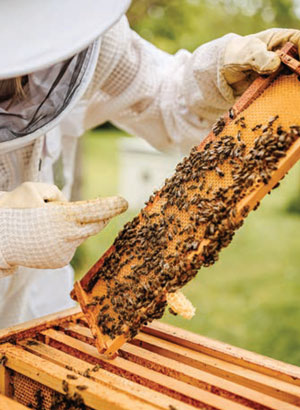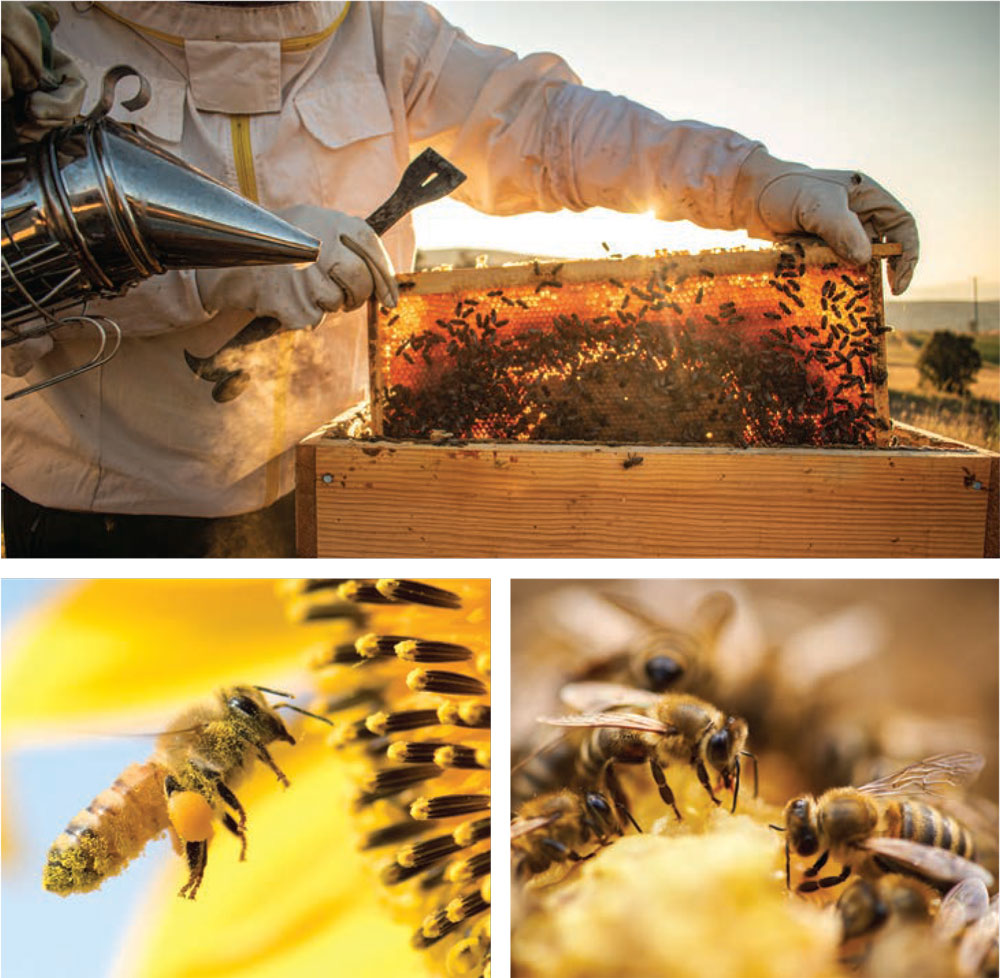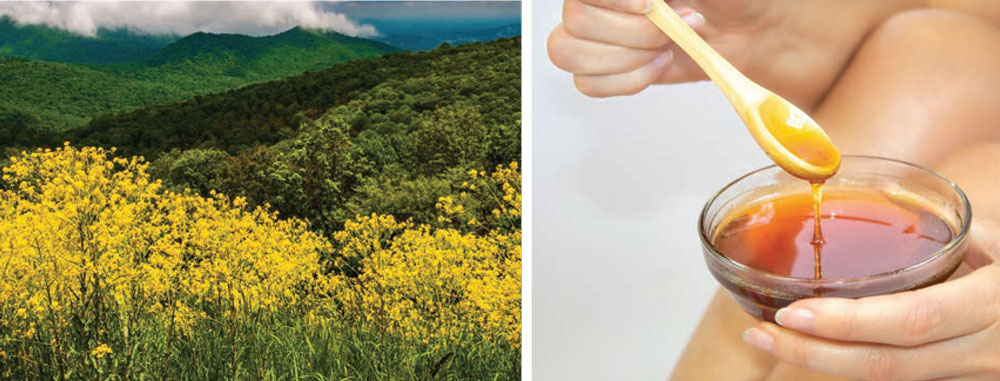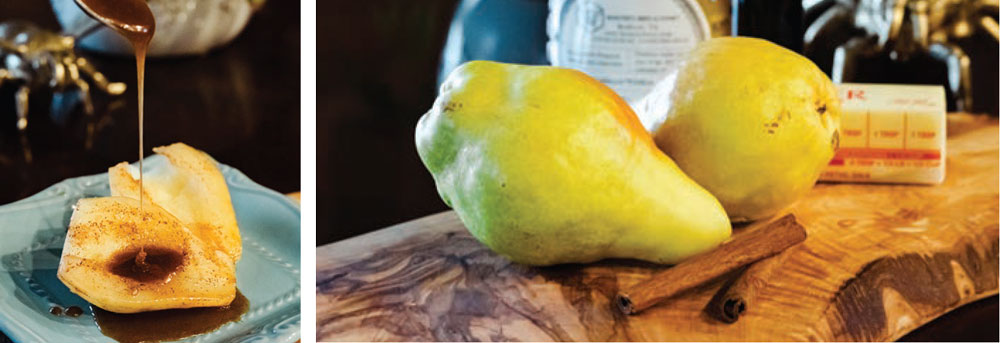OH, HONEY!

Nutritious & Delicious
More than just a natural sweetener, honey has been used for thousands of years for its sweet flavor and its medicinal benefits. Whether you pour it on your pancakes or rub it onto a burn, honey is a household staple that no home should be without.
Busy bees
When the weather warms and plants begin to flower, honeybees leave their hives to gather nectar and pollen and then return for the process of making honey. “Bees will travel 2 to 5 miles from their hives to collect nectar,” notes Ann Zudekoff, member of the Piedmont Beekeepers and the Peaks of Otter Beekeepers. “They always return to the hive they left.”
Back at the hive, these busy bees deposit the nectar into honeycomb cells. They then fan their wings to extract the excess water and seal the cells with a waxy substance. Beekeepers remove the waxy substance and scoop out what is now the honey. A single bee produces about 1/12 of a teaspoon of honey per lifetime, which is only about 5 to 6 weeks. With proper care, a typical hive may yield about 50 pounds of surplus honey per year.
“A pound of honey is about a cup and a half,” notes Zudekoff. “Honey has a reputation as being a food that never spoils. While it’s true that honey will last, you’ll never get better honey than the day it comes out of the hive.”
Sweet satisfaction
If you’re simply stirring a teaspoon of honey into a mug of hot tea, the flavor of each specific type may be lost. To really note the individual essences, try spreading some honey on a piece of toast or a biscuit or just spoon a bit right out of the jar! Since honey comes from the nectar of plants, there’s simply no way to quantify the variety available. Each plant contributes unique flavors and colors, from light to bold in taste, from yellow to brown in color.
Much of the honey in this area is wildflower honey. Wildflower is a subtle, sweet honey that’s good in teas and is wonderful paired with sharp cheddar cheese on a charcuterie board. Also in this area, you’ll find sourwood, black locust and clover are good choices for a light honey. Buckwheat is a bolder, darker honey. Other flavors to look for: lavender, sage, orange blossom, dandelion and alfalfa.
If you want to try a variety of honeys, attend a club meeting in your area. Many clubs will offer an annual tasting event and members often bring their own honey to meetings to share with attendees.
Pure honey is tasty on its own, but infused honeys are flavorful treats as well. You’ll find honey infused with bourbon, spices, herbs, fruits, vegetables and more to provide a unique taste and offer wide appeal.
“Hot honey” has become a fad in recent years. Spicy peppers are added to the sweet liquid, resulting in a spicy/sweet combination that gives your tastebuds a thrill. Zudekoff recently won an award for her hot honey at a convention in Kentucky. “I added Carolina reaper peppers to my honey,” she explains. “Just a bit. Nothing to blow your head off. The sweet, then spicy explosion worked really well.” Her entry was one of 1,100 at the convention.
Medicinal value
In addition to its use as a natural sweetener and a delicious treat, honey also has the reputation for medicinal value. “Most people like honey for its effect on seasonal allergies,” notes Laura Carwile, manager of George’s Seed, Feed and Grow Shop in Forest. “Since bees are grabbing the nectar and pollen from trees and plants in your area, you can introduce yourself to the allergens a little at a time by enjoying local honey. Then, when everything is in full bloom, your allergy symptoms may not be as bad.”
Rich in antioxidants, antibacterial and boasting anti-inflammatory agents, honey has been used for centuries as home medicine to treat a variety of acute and chronic illnesses. Honey has a positive impact on blood pressure and cholesterol levels, and when compared to white sugar, honey has a smaller effect on blood sugar in those with diabetes. Honey also improves gut health; it doesn’t ferment in your stomach like refined sugars do.
People often use honey for a simple sore throat or even for serious wounds and burns. Honey kills bacteria, thus medical-grade honey is sometimes used on bandages for burn patients. Honey can be rubbed on rashes to reduce skin irritations, and you can even eat the honeycomb! For children under the age of 1, ingesting honey is not recommended.
As with any purchase, it’s wise to read the label carefully. Some imported honey in large box stores is pasteurized or contains additives. “For pure honey, buy it straight from the beekeeper,” says Zudekoff. “Meet and chat with the beekeeper. It’s the honey, not the bottle, that’s important.”
Zudekoff recommends buying the honey at local farmers’ markets or looking for a local apiary, a location where hives of bees are kept. Apiaries vary in size from a hobbyist’s hive to a commercial operation.
 The buzz on beekeeping
The buzz on beekeeping
If you’re interested in beekeeping, organizations such as Piedmont Beekeepers and Blue Ridge Beekeepers are great places to start. Carwile, in her role as manager at George’s, works with all the beekeeping groups to provide needed supplies. “We have starter kits for about $200 that come with everything you need (except the bees) to get started: frames, base, inner and outer covers.” George’s also sells honey from five local beekeepers.
Zudekoff was careful to warn first-time beekeepers. “There’s a reason we call it beekeeping and not honey collecting,” she laughs. “That first year, the emphasis is really on growing your colony. Lots of factors go into actually being able to harvest honey: the strength and health of the colony, the weather, the beekeepers, a little bit of luck. It’s different every year. The focus is really on the bees and, if you get honey, that’s a plus.”
The Virginia Beekeeping Teachers Consortium conducts classes annually through local clubs for those wanting to become beekeepers. Even if you’re not interested in beekeeping, you can positively impact the honey supply by planting native pollinator-friendly plants in your yard.
Nutritious and delicious, honey can be stored on your table and enjoyed in recipes or straight out of the jar! Its yummy goodness combined with its medicinal uses will make you want to head right down to your local farmers’ market.
Honey Baked Cinnamon Pears
- 4 medium pears
- 3 Tablespoons of honey
- 2 Tablespoons of butter
- 1/2 teaspoon vanilla extract
- 1/2 teaspoon cinnamon
Preheat the oven to 400°F. Peel pears with a vegetable peeler, cut off the ends and then halve the pears. Scoop out the core. Place the pears face down in a glass baking dish. In a small bowl, combine the honey, cinnamon, vanilla and butter and heat in the microwave for 30 seconds. Pour half of the sauce over the pears. Bake for 25 minutes until soft and slightly brown. Pour the remaining sauce over each pear before serving. ✦
anti-inflammatory agents, antibacterial, antioxidants, beekeeping, hive, honey, honeybees, honeycomb cells, hot honey, infused honeys, medical-grade honey, medicinal value, nectar, pollen, waxy substance, wildflower honey










